| Organic Seeds | Edible Plants | Organic Pest Controls | Books | Tools, Propagation & Fertilisers | Sprouting & Microgreens | Poultry Supplies | Specials & Gift Ideas |

Top

We will send an email to this address*
when is next available
* we will use this email address only for this notification and then we will delete it.
 Home
Home
Green Harvest Organic Gardening Supplies is permanently closed as of 5pm on 1-11-2023.
We will not be taking orders by this website, in person, by phone or email. Our display garden and retail shop are closed forever.
Read more...
Phone:07 54357000
Phone calls will only be responded to sporadically and only in reference to orders placed prior to 2-11-2023. All the useful growing and organic pest management research and resources are available on this website for a while still.
 Healthy Roses - The Organic Way © Frances Michaels
Healthy Roses - The Organic Way © Frances MichaelsThis information is primarily written for gardeners in warmer areas of Australia, who desire to grow roses but want to avoid the use of toxic chemicals. For while it is possible to grow roses in most areas of Australia, the further north you go the harder it can become. Both choosing the right variety for your area and selecting the right spot in your garden are critical.
Plant Selection
Where possible, try to buy roses from local nurseries, as they are more likely to be on the correct rootstock for your area. Good choices for northern NSW and SE Queensland include old-fashioned roses such as tea, noisette and china roses.
Location
Roses will tolerate a wide range of soil types including clays, although a fertile loam with a pH of 6.5 to 7 is ideal. They need to be planted in full sun in an open position, space your rose bushes far enough apart to encourage good air circulation as this is essential to reduce pest and fungal problems.
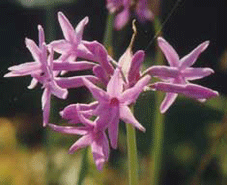 Growing Requirements
Growing Requirements- Choosing suitable companion plants will help to keep your roses healthy. Good choice include garlic and onion chives, society garlic (pictured) and garlic itself to repel pests. Plants to attract and feed beneficial insects such as parasitoid wasps and hoverflies include Sweet Alice, coriander, dill, gypsophila and lucerne.
- Avoid overhead watering, especially late in the afternoon or evening. Aim to keep the leaves as dry as possible, although an occasional hosing to wash off dust will not harm the plants. Water deeply to improve drought resistance, shallow watering encourages shallow rooting.
- Mulches are important both to keep the roots cool and to reduce weed growth. Weeding or digging around the roots can cause damage to the shallow root system. Mulch with hay to 12 cm deep, lucerne hay is preferred if it is available. Keep the mulch away from the stem of the plant.
- Feed your roses regularly during their period of active growth with well-rotted manure or compost. Always add some sulphate of potash to blood and bone as it lacks potassium. Spray seaweed onto the leaves, in the afternoon, every 2 to 3 weeks. This raises the pH of the leaf surface and adds trace elements improving disease resistance.

Roses, such as hybrid teas, definitely need pruning and it is better to have a go, than leave them unpruned. The right time to prune varies with the climatic area and the rose variety. Aim to improve air circulation and therefore reduce disease by pruning to keep the centres open.
Hybrid Teas and Floribundas
To prune first cut out any dead branches or twigs, then select the old stems (grey or brown bark) and remove them completely, prune remaining stems back by one-third. Check for any suckers that come from below the graft union and cut them off as low as possible.
Climbing Roses
Prune climbing varieties regularly as this can become a very difficult task if neglected for a few years. Tie the long canes down as close to the horizontal as possible, this encourage short flowering stems, called 'spurs' to grow. Every year remove some of the older canes and encourage new canes to replace them. Cut back hard any spurs on canes that are left.
'Old' Roses
Many old-fashioned roses grow more like garden shrubs and need little pruning, except to remove dead wood. If you need to prune varieties that only flower once, do it immediately flowering finishes. Examples of these include the banksia rose, 'Lorraine Lee', 'Nancy Haywood'.
Natural Pest Control
Black Spot
Black spot is a fungal disease which can be a major problem all year round in warmer areas. The fungal spores need to be immersed in water for a number of hours in order to germinate so doing everything possible to reduce moisture on the leaves and improve air circulation is important.
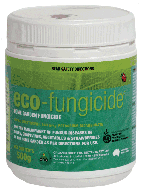 A new organically certified fungicide is now available to help deal with this problem
eco-fungicide.
A new organically certified fungicide is now available to help deal with this problem
eco-fungicide.
- Remove any black spot damaged leaves as they appear and pick up any on the ground, a pair of long tongs is good for this, as black spot can over-winter in the fallen leaves.
- Mulching acts as a barrier and helps restrict the spread of fungal spores from the soil onto the plant.
- A deficiency of potassium makes roses more vulnerable to this disease so regularly add sulphate of potash in spring, summer and autumn.
- Through the growing period it is a good idea to alternate a foliar spray of seaweed with one of Condy's crystals at two week intervals. To make a spray with Condy’s crystals mix 1 teaspoon to 5 litres of water.
- Seaweed sprayed onto the leaves changes the pH of the leaf surface making it less attractive to the fungal spores. It also strengthens the cell walls making it more difficult for the invading fungi.
- Lime sulphur can be used as a preventative fungicide on leafless roses in winter.
 Aphids
AphidsAphids are sucking insects that have a large number of natural enemies including lacewings, hoverflies, ladybeetles and parasitic wasps. They tend to be a problem where the use of pesticides is wiping out the natural enemies or at times of the year when natural enemies are not present in large numbers.
- Avoid high nitrogen fertilisers as these will stimulate aphid reproduction.
- Hang sticky yellow traps above rose bushes to catch the first generation of winged aphids flying in.
- Keep an eye out for aphids on soft, new growth, either squash between your fingers or spray with Natrasoap.
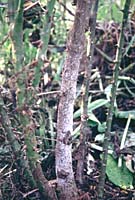 Scales are small sap-sucking insects that often
go unnoticed, but they can do damage out of all proportion to their size. Scales found on roses include
cottony-cushion scale, red scale and rose scale. Insecticidal potassium soap sprays such as
Natrasoap work by blocking the
breathing pores and dissolving the scales outer covering so they dehydrate and die, they will not harm beneficial
insects and have a very low toxicity to people or pets. Oil sprays such as
Eco-Oil kill all stages of scale
insects by suffocation. It has a low impact on beneficial insects.
Scales are small sap-sucking insects that often
go unnoticed, but they can do damage out of all proportion to their size. Scales found on roses include
cottony-cushion scale, red scale and rose scale. Insecticidal potassium soap sprays such as
Natrasoap work by blocking the
breathing pores and dissolving the scales outer covering so they dehydrate and die, they will not harm beneficial
insects and have a very low toxicity to people or pets. Oil sprays such as
Eco-Oil kill all stages of scale
insects by suffocation. It has a low impact on beneficial insects.Hardy Roses for South East Queensland and Northern NSW
Many of these are 'old' roses and so only flower once, usually from late spring into early summer. They often have the advantage of being vigorous, fragrant and disease-resistant, qualities that are sometimes lost with modern breeding.
Climbing Roses
Banksia Rose, yellow or white.
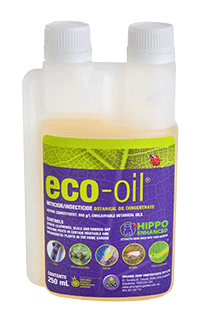 Tea Roses
Tea RosesTea roses can be treated more like a garden shrub than a rose, as they require little pruning. They are vigorous, healthy and prolific in flowering. Good choices include: 'Monsieur Tillier', 'Duchesse de Brabant' (syn. Montville rose), 'Lady Hillingdon', 'Safrano', 'Dr Grill', 'Mrs Reynolds-Hole', 'Anna Oliver', 'Frances Debreuil', 'Penelope'.
Noisettes
Generally climbers to some extent, flowers are in clusters with smooth stems and few thorns. Good choices include: 'Crepuscule', 'Lamarque', 'Reve d'or', 'Blush Noisette', 'Autumnalis'.
China and Hybrid Chinas
Good choices include: 'Cecile Brunner', 'Perle d'or', 'Sophie's Perpetual', 'Mutablis'.
Hybrid Teas
A selection of the hardier hybrid teas includes: 'Double Delight', 'Sylvia', 'Dreaming', 'Amberlight', 'Iceberg', 'Mister Lincoln', 'Peter Frankenfeld', 'Christian Dior', 'Pascali', 'Gold Medal', 'Olympiad', 'Sheer Bliss', 'Spiced Coffee', 'Aotearoa', 'Ingrid Bergman', 'Voodoo', 'Touch of Class', 'Remember Me', 'Just Joey', 'Brandy', 'Peace'.
Calendar Of Rose Care For South East Queensland
(or subtropical areas in the Southern hemisphere).
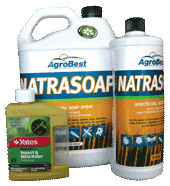 Spring
Spring
- Fertilise with Life Force Gold, up to 100 g per bush, depending on soil fertility, mixed with 100g of sulphate of potash per bush; potash improves disease resistance (don't use muriate of potash, it has a harmful effect on beneficial soil organisms). Apply a good mulch of well-rotted compost and lucerne hay.
- Spray new foliage in the afternoon with Seaweed, repeat every 10 - 14 days.
- Fertilise repeat bloomers in mid to late summer.
- Again apply 100g of sulphate of potash per bush.
- In the subtropics, hybrid tea and floribundas should be hard-pruned in February, this gives the plant a rest and stops flowering in the heat and humidity of the wet season, when flowers will just collapse anyway. Remove all rose prunings as they can harbour disease. The plant should be ready to flower again by late March, when it is cooler.
- Roses often flower well from March to July, remove spent blooms on a regular basis.
- Fertilise again with Life Force Gold and 100g of sulphate of potash per bush.
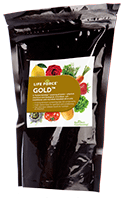
- In cool areas this is the main period for pruning.
- Trim bushes lightly in August, before the cold westerly winds start blowing.
- Spray with lime sulphur to kill fungal spores.
- Dust the soil with lime to provide calcium.
Coriander
Dill
Eco-Fungicide
Eco-Oil
Garlic
Instant Humus
Lucerne
Natrasoap
Life Force Gold
Seaweed (Natrakelp)
Society Garlic
Sticky Yellow Traps
Sweet Alice
 Home
Home
Green Harvest Organic Gardening Supplies is permanently closed as of 5pm on 1-11-2023.
We will not be taking orders by this website, in person, by phone or email. Our display garden and retail shop are closed forever.
Read more...
Phone:07 54357000
Phone calls will only be responded to sporadically and only in reference to orders placed prior to 2-11-2023. All the useful growing and organic pest management research and resources are available on this website for a while still.
No liability will be accepted by Green Harvest, its owners or employees as to the accuracy of any information. No responsibility will be taken for damage to property or persons due to information given about a product or technique. No responsibility will be taken for the loss of a crop or income due to information given about a product or technique.
 Shopping here is private and secure.
Shopping here is private and secure.
Copyright © 2001 - 2024 Green Harvest Organic Gardening Supplies
No part of this website may be reproduced without permission of the owner